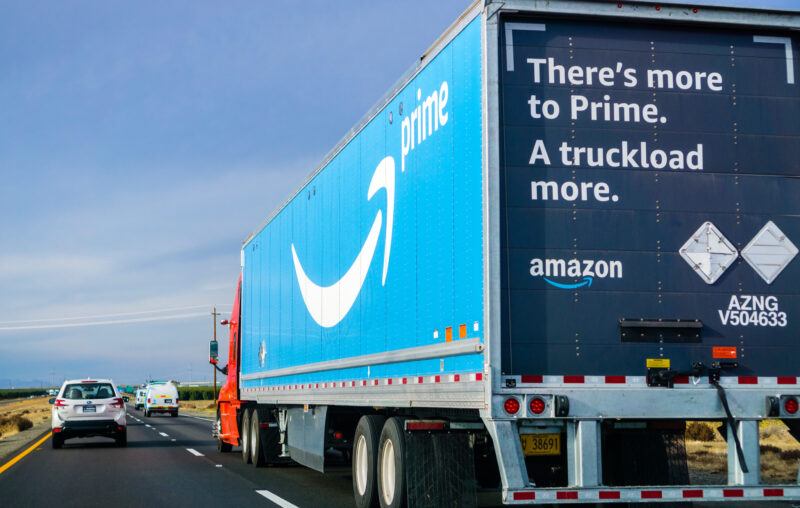The Backwards Insinuation That Amazon Hires ‘Dangerous Truck Drivers’

Reprinted from RealClearMarkets
Back in the early 2000s, a reporter followed Amazon founder Jeff Bezos around with an eye on better understanding the indefatigable entrepreneur. In following Bezos, the reporter found himself with the CEO in a bursting, vibrant shopping center. Odd right?
Actually, not at all. Bezos was clear that the company intent on enabling shopping via computer would never replace the shopping center. The community of such venues would never lose its luster, plus there’s an obvious immediacy to brick & mortar purchases that helps explain why the rise of the internet hasn’t coincided with the disappearance of “live” shopping.
It’s obvious Bezos himself believed what he said long ago. Evidence supporting the previous claim was the growth of physical Amazon-branded stores on his watch. Greater evidence is Amazon’s ongoing pursuit of quick delivery.
As Amazon customers are well aware, it’s more and more true that orders placed on the retailer’s website are completed in time that can be measured in hours, or a day, versus the 2, and 3 days that used to be the norm. If Amazon can provide immediacy, which is what customers want (see the popularity of brick & mortar), it can better compete with corporations that provide a high level of immediacy via physical locations. As a consequence of its desire to give its customers what they want, Amazon has built more warehouses, and per the Wall Street Journal’s Christopher Weaver it has “rapidly built a sprawling network to move merchandize around the nation’s highways.”
Competition is wonderful. What Weaver describes is wonderful. Competition for our dollars means better and better service from online and physical retailers alike. Nothing original there. Except that Weaver would claim that efforts by Amazon to bring Seattle (where Amazon is headquartered) closer to its customers in a figurative sense comes with tradeoffs. According to Weaver, “Many of the trucking companies it hired for all that driving are more dangerous than their peers, sometimes fatally so.”
Readers can probably detect Weaver’s insinuation fairly easily. What the Journal reporter implies is that in the pursuit of profit, Amazon cut corners. And in allegedly cutting corners, Amazon created externalities. Fatal ones to be exact.
The insinuation is hard to countenance. A major reason it is has to do with the internet that Amazon gave life to, and that also gives Amazon life. Information, good and bad, is instantaneous in a wired world full of people carrying computers around in their pockets. Does Weaver really think Amazon would risk its good name in this way? And its name is very good. As a generally critical Frontline documentary somewhat sheepishly acknowledged, high regard for Amazon is bipartisan. Which is quite something in these polarized times. High reputation is extraordinarily hard won, and because it is, the insinuation that Amazon blithely hires “Dangerous Trucking Companies” (part of the WSJ headline) as a business strategy is hard to take seriously. Furthermore, such a headline ignores the bigger, more important truth about the Seattle giant.
While reporters, politicians, and pundits would have us believe that the much-admired company operates sweatshops defined by cruelly low pay, the reality is that Amazon continues to invest enormous sums in the automation of all that it does, including the packaging of its merchandize ahead of shipment. Stop and think about the previous truth for a second, and think about it in terms of what automation of human effort has long meant for workers: the answer is greater productivity, and with greater productivity comes greater pay. Amazon’s investment in automation is its acknowledgement of what’s lost on skeptical reporters: low-paid workers are very expensive. If Amazon can automate away aspects of work, it can create working conditions that are better, more productive, and more remunerative.
Please think about all of this with trucking in mind. Precisely because Amazon has a brilliant reputation, it can’t afford accidents on the road. Talk about expensive. That it’s expensive means that as soon as trucking can be automated in credible fashion, readers can be sure that Amazon will be switching from fallible human drivers to more reliable robots. To which some will say Amazon aims to operate without workers, which is a supposition that is astounding for its foolishness.
Really, where in the world and where in the history of mankind have locales defined by a lack of technological advance also been the locales most pregnant with well-compensated opportunity? Tick tock, tick tock….
The simple truth is that technology and automation don’t put us into breadlines as much as they propel us humans to greater employment heights precisely because they remove the most difficult aspects of work from work so that humans can specialize in areas that most elevate them. Put another way, the tractor and fertilizer are easily the two biggest job killers in the history of the world, and no one’s crying about either. We’re eating, and our increasingly productive work pays for the eating, and all manner of other things.
Bringing it back to Amazon, it’s thoroughly obnoxious to insinuate that the corporation is scrimping on truck drivers without regard to safety and life, and with full regard for the alleged “bottom line.” The reality is that Amazon invests tens of billions every year with a goal of improving working conditions and pay, and does so – yes – with an eye on the “bottom line.” In other words, Amazon is investing billions in a transportation future unlike the present precisely because drivers are fallible.










